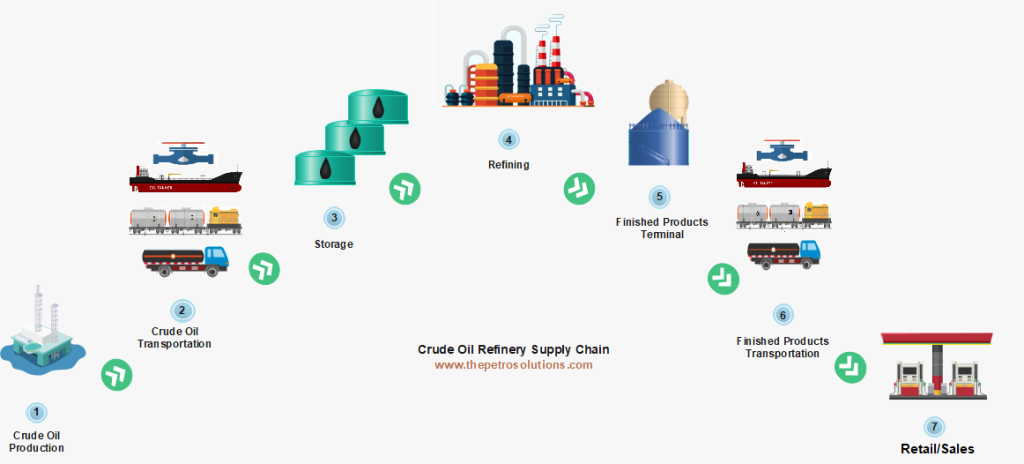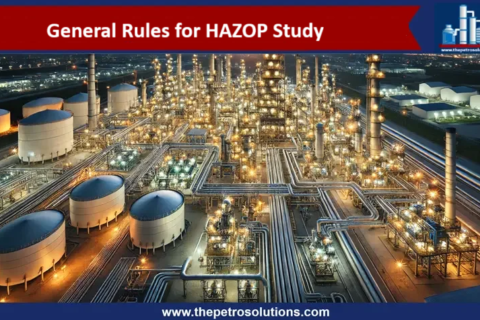The supply chain of crude oil from extraction to refining is a complex process involving multiple steps and stakeholders. It is important to note that the supply chain of crude oil can vary depending on the location and the specific players involved. Additionally, the crude oil production, transportation, refining and distribution of crude oil products are heavily regulated by government agencies in different countries.
For crude oil, intermediate and finished petroleum products, inventory management is necessitated to avoid storage overruns or no ullages and shortage of crude feed or finished products. Following are the key steps of the crude oil refinery supply chain, abruption in any of the steps will badly affect the streamlined operation of the oil and gas both upstream and downstream.
1. Crude Oil Production
The first step in the oil supply chain is production. During production, crude oil is produced on both land and at sea. Oil production includes drilling, extraction, and recovery of oil from underground. Crude oil is extracted from underground reservoirs using drilling methods such as horizontal drilling and hydraulic fracturing.
Crude oil can be sourced from various sources, Refineries obtain crude oil from various sources, including domestic production and imports. The crude oil is purchased from oil producers or purchased on the global market.
The sources of crude oil that a refinery relies on can be influenced by various factors, including proximity to the source, cost, quality, and political stability. Refineries may also choose to source crude oil from a variety of sources in order to diversify their supply and reduce their exposure to supply disruptions or price volatility.
2. Crude Oil Transportation
Various modes of transportation are applied for the movement of crude oil from the point of extraction and production to the sale point or direct to the crude oil refining site. The extracted crude oil is transported to its destination via pipeline, tanker truck, or tanker ship. Following is the detail of modes of crude oil transport;
Pipelines: Pipelines are the most common mode of transportation for crude oil, as they are the most cost-effective and efficient way to transport large quantities of oil over long distances.
Tanker Ships: Crude oil can also be transported by tanker ships, which are used for long-distance transport of crude oil, particularly when the oil is being imported from overseas. Marine transport, largely via barge or tanker, is the second cheapest mode of oil shipment. This is especially true for companies that export crude oil and petroleum products internationally.
Tanker Trucks: Smaller quantities of crude oil can be transported by tanker trucks, which are used for short distances or for transporting crude oil from remote locations where pipelines do not exist. Over-the-road transportation is the most expensive, inefficient means of crude oil transportation.
Rail: Crude oil can be transported by rail, either in tanker cars or through the use of specialized trains known as “unit trains.” This mode of transportation is used for shorter distances or when pipelines are not available.
3. Crude Oil Receiving and Storage
Once the oil has been produced, it is transported to short-term storage. Short-term storage serves as the
staging area for crude oil distribution throughout the entire supply chain. Storage facilities allow for adjustments in supply and demand throughout the entire supply chain. Crude oil storage can take place at several locations along the supply chain, including at the point of production, at the refinery, and at storage terminals.

4. Crude Oil Refining
At the oil refinery, crude oil is processed in a crude distillation tower to separate it into various products such as gasoline, diesel, LPG, and jet fuel. This process is known as crude oil refining and also provides feedstock for petrochemical industries. basics of all refineries are the same, but the specific operations vary and depend on the properties of crude oil and the desired finished products. The oil refining process comprises many steps to achieve the desired products and their quality.
5. Terminal
Petroleum product storage terminals typically include a network of storage tanks, piping, and loading/unloading facilities. The storage tanks can range in size from small tanks used for buffer storage to large tanks capable of holding millions of barrels of products. Refined fuel that is ready for use is transported to terminals. Terminals are located closer to transportation hubs and are the final staging point for the refined fuel before the point of sale. Managing petroleum products storage is critical in the refinery supply chain to work as a buffer against supply chain abruptions, price changes and sales variations.
6. Finished Products Transportation
Once the refined fuel leaves the terminal, it is transported to its final point of sale, which includes fuel stations and airports. Trucking, shipping, and delivery lines provide the final, finished product which can be delivered across the country.
7. Retail/Sales
Retail outlets such as gas stations sell refined products to consumers for use in vehicles, industrial equipment and power generation.
Top References
Certified Functional Safety Professional (FSP, TÜV SÜD), Certified HAZOP & PHA Leader, LOPA Practitioner, and Specialist in SIL Verification & Functional Safety Lifecycle, with 18 years of professional experience in Plant Operations and Process Safety across Petroleum Refining and Fertilizer Complexes.
- Nasir Hussainhttps://thepetrosolutions.com/author/admin/
- Nasir Hussainhttps://thepetrosolutions.com/author/admin/
- Nasir Hussainhttps://thepetrosolutions.com/author/admin/
- Nasir Hussainhttps://thepetrosolutions.com/author/admin/






